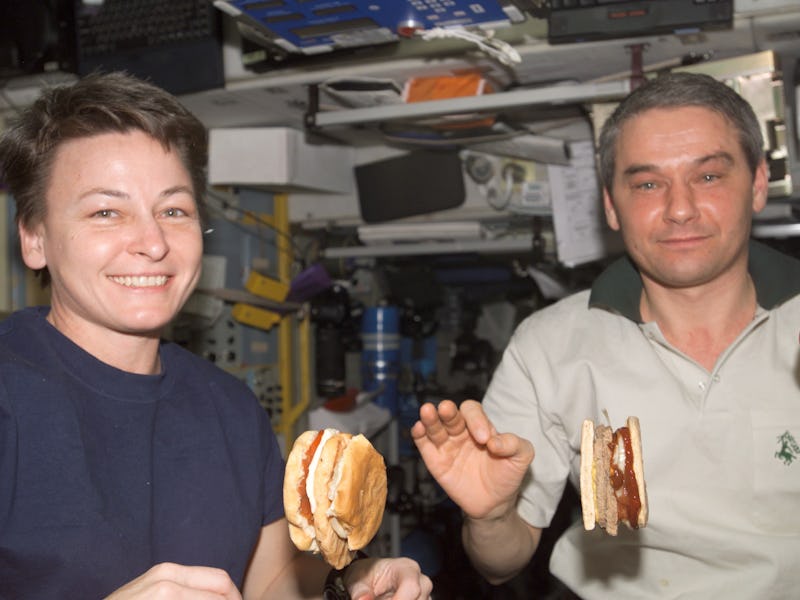How NASA Plans to Replace Astronaut Ice Cream With Sustainable Food
It's time for explorers, and maybe the rest of us, to eat like hippies.

There is a very obvious tension within the green movement between those who want something local and pure and those who want something efficient and sustainable. Astronauts, who don’t have the luxury of locavorism or rallying against GMOs, fall into the latter group by default. In fact, they are the posterboys and girls for it because efficient consumption is one of the prerequisites for life in the fallow vacuum of space.
Each astronaut living in the International Space Station uses seven gallons of water a day, 78 percent of which gets recycled. Only half a pound of food is split between a crew of six daily. Urine and even perspiration is recycled. All this in just 32.85 square feet of space (although the luxuries of zero-G mean it’s more appropriate to think of this as 32,300 cubic feet. But that’s still some close-quartered living space).
Meanwhile, the average American family of five blows through an average of 54 gallons of water a day per person — hardly any of which is reclaimed — and tosses out 4.5 pounds of food. Very few of us recycle our pee and sweat, and we give ourselves roughly 3,000 square feet in which to do all this consumption.
Sustainability is an Earthly goal, but clearly it’s worth looking up for inspiration.
NASA’s Advanced Food Technology Project is focused on developing a food system that can be utilized in space and on other planets and moons. The goal is to minimize waste, volume, and energy costs in growing and delivering those foods while maintaining high levels of nutrition. There are very specific hurdles between scientists and that goal: Most food currently eaten on the ISS, for example, is freeze-dried and shrink-wrapped, keeping it preserved at the expense of nutrition. In addition, storing all of that food takes up precious space and energy that ought to be conserved and allocated to more important things. NASA thinks a crew flying to Mars would need about 7,000 pounds of food onboard. Yikes.
Russian Borscht soup (beet soup) in tube, consumed by cosmonauts in space
The AFT wants to jettison those pounds and put astronauts on a vegan diet of freshly grown fruits and vegetables. The reasoning? It’s easier to preserve vegan foods for longer than it is to preserve meat and dairy. If we can find a way to grow fruits and vegetables up on a ship headed for Mars or wherever, astronauts will be able to start enjoying fresh foods once again and stay healthier overall.
And the psychological benefits would be well-worth it. Astronauts would be thrilled to have access to freshly-grown lettuce, spinach, carrots, tomatoes, onions, peppers, strawberries, herbs, and much more. A space-board garden would also help clean the air onboard by using excess carbon dioxide and providing brand-spanking-new oxygen. A perfected filtration system could use excess irrigation as drinking water.
Some space researchers want to take things a bigger step further and look at food in space as a culinary opportunity. Architect Sandra Hauplik-Meusburger has thought hard about how we can overhaul in the consumption and production of food in space. While she’s in large agreement with NASA’s desires to start having astronauts grow fruits and veggies aboard spacecraft, she emphasizes the advantages of installing more food facilities to allow men and women to cook nicer meals and eat tastier entrees. Hauplik-Meusburger insists that a richer menu would improve quality of life in space tremendously. Imagine being able to whip up your favorite Thai or Italian dishes while hurtling around the universe at tens of thousands miles per hour.
But she’s not talking about cooking through conventional means, which, in a zero-G environment, is damn near impossible, not to mention tremendously wasteful. Hauplik-Meusburger thinks 3D printers could cut ingredients and cook the whole plate in a relatively quick manner, while using only what energy is needed and no more.
Gone are the days of Astronaut Ice Cream and liquids in aluminum tubes. Dinner in space will soon more closely resemble how it’s done here on Earth — all while saving on energy and limiting excess waste.